Singapura Cat
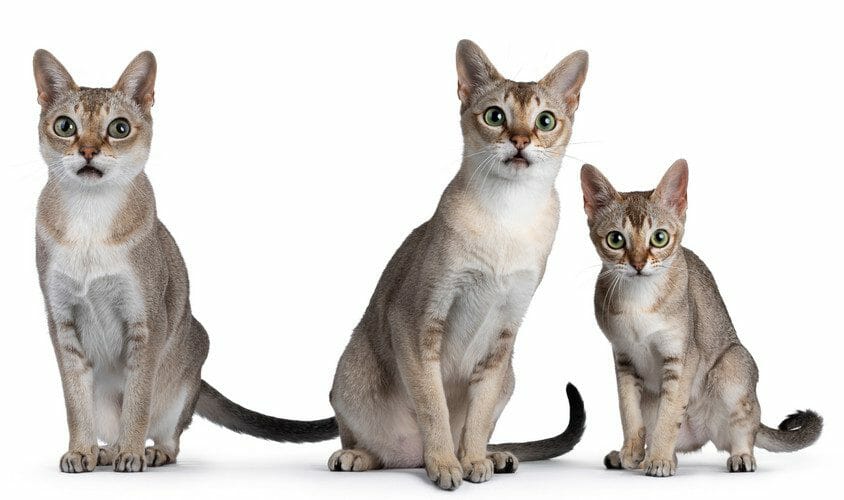
Singapura Cat Facts
The Singapura cat is the smallest domestic feline breed in the world. The breed was established in the 1970s. However, its origins remain a source of controversy. The initial story of the breed’s discovery was that American cat fanciers, Tommy and Hal Meadow, brought three cats back to the United States from the streets of Singapore. The breed was recognized by the International Cat Association in 1979 and by The Cat Fanciers’ Association in 1982.
The story gets a little murkier when the Tourist and Promotion Board of Singapore decided they wanted to use the breed as a national mascot. While researching the breed’s origin story, it came to light that the cats did not originate from Singapore. Instead, they were brought to Singapore from the United States by Tommy and Hal Meadows. Furthermore, it is also believed that the initial Singapura cats were actually a cross between Abyssinian and Burmese cats and were bred in the United States prior to the Meadows’ visit to Singapore.
Regardless of this fact, the Cat Fanciers’ Association still maintains the status of the breed as being natural. Despite discovering that the cats were not native to Singapore, the breed has still been used by the Tourist and Promotion Board as a mascot since 1991.
In Singapore, the breed is referred to as “Kucinta,” which is a portmanteau of the Malay words for cat and love. In 2008, a DNA study was published that stated that there is little to no genetic difference between the Burmese and Singapura breeds.
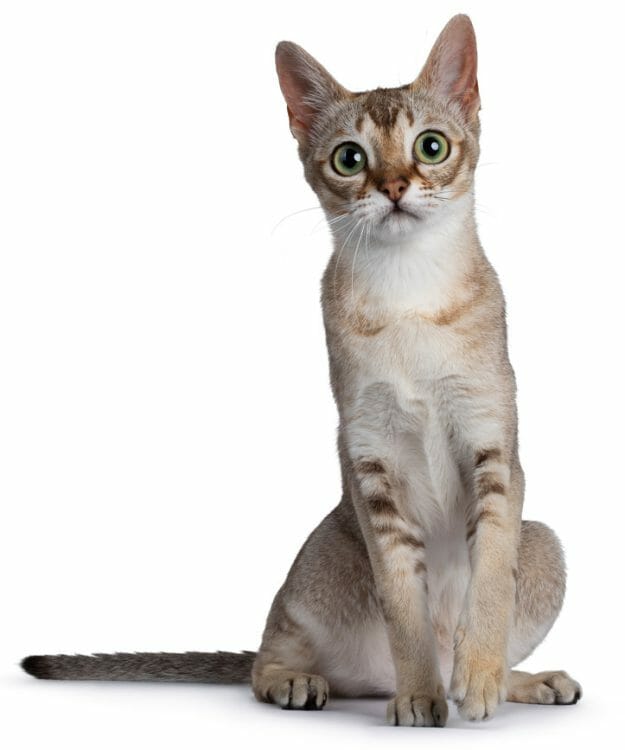
Singapura Cat Personality
Although they are very small, Singapura cats have big personalities. Typically, these felines are extroverted, curious, and friendly. Always wanting to be the center of attention, Singapura are assertive, playful, and intelligent.
A Singapura will not just look like a kitten when fully grown, it will also act like one—continually demanding to be played with. Known for being vocal, Singapura cats have a pleasant meow that is often endearing to their owners.
The sociable Singapura makes a suitable pet for families with young children and can live in a home with other animals. The breed does particularly well when other cats are also present.
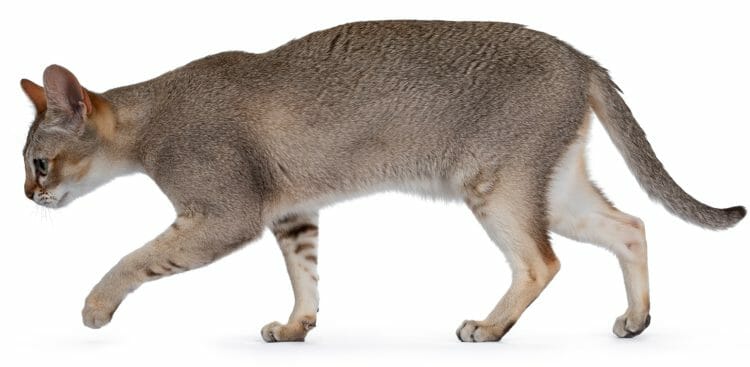
Singapura Cat Appearance
The Singapura is a relatively muscular and stocky cat. The average female weighs just four pounds while the average male weighs six pounds. The breed has characteristically large cupped and pointed ears and green or amber almond-shaped eyes. The blunt-tipped tail is slender and slightly shorter than the rest of the body.
The coat of the Singapura is a ticked tabby pattern that has alternating dark and light strands. The chest, chin, and muzzle of the cat all take their color from the lighter of the alternating bands.
In cat registries, the Singapura is officially recognized in just one color: sepia agouti. This is described as dark brown ticking on a background described as a “warm old ivory” or “yellowish ivory” color.
The short coat of the Singapura will not excessively shed. However, the breed is not hypoallergenic. This is because the skin of the felines carries a considerable amount of dander, which can irritate people with allergies.
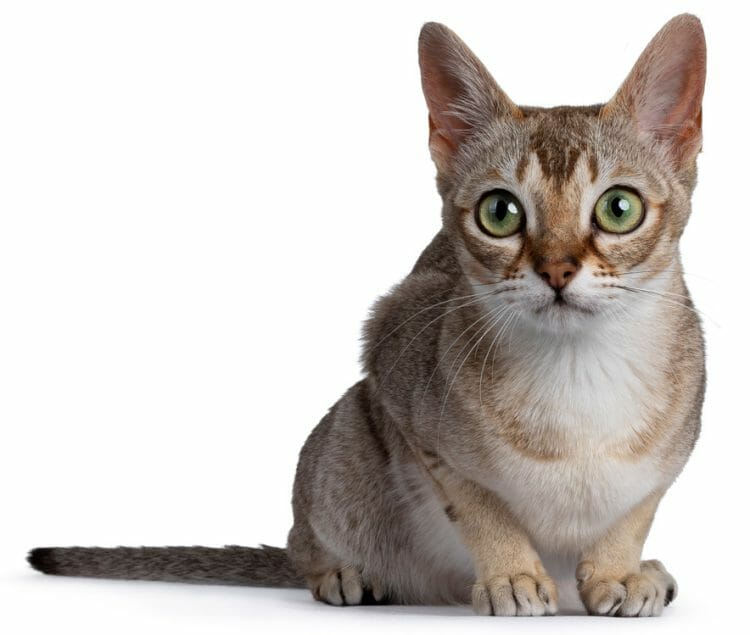
Singapura Cat Grooming
Because the Singapura has quite a short coat, these felines are easy to groom. Combing the cat weekly will ensure that any dead hair that may usually end up on floors or furniture is removed. Regular brushing also aids with the distribution of skin oils and keeps the coat shiny.
There is little need to bathe a Singapura. However, bathing is quite straightforward. After bathing the cat, do not use a blow dryer or the feline’s coat will fluff up.
In addition to brushing, it is important to trim the cat’s nails weekly. The Singapura does not enjoy having its feet touched. Therefore, is important for a Singapura cat to get adjusted to having their nails trimmed while still a kitten.
It is important to also clean its ears when they appear dirty. To clean the ears, use a gentle product recommended by a veterinarian.
As cats can develop problems such as periodontitis, it is essential to brush their teeth often. Using a toothpaste recommended by a veterinarian will ensure the cat’s breath is fresh and the threat of bacteria is minimized.
Singapura Cat Health
An issue that reputable Singapura cat breeders are concerned with is a lack of genetic diversity—a problem the breed shares with Burmese cats. In a 2007 study, the Singapura was found to be the least genetically diverse breed out of the 22 cat breeds tested. The reason for this is that there were very few foundation cats. An outcrossing program has been approved to address this issue.
Birthing can also be problematic for Singapuras. This is because they are often affected by a condition called uterine inertia, which causes a weakening of the muscles. Singapura kittens often need to be delivered by cesarean section. In addition, a Singapura cat will only give birth to a litter of two or three kittens. This is one of the reasons why the breed is so rare.
Pyruvate kinase deficiency is a health concern that can lead to anemia and other problems with the blood. This can be treated with a bone marrow transplant. Carriers of this disease may show no symptoms, while others may become anemic. All Singapura cats should be tested for this condition before breeding.
Other health concerns that may affect the breed include hypothyroidism, renal failure, and diabetes.
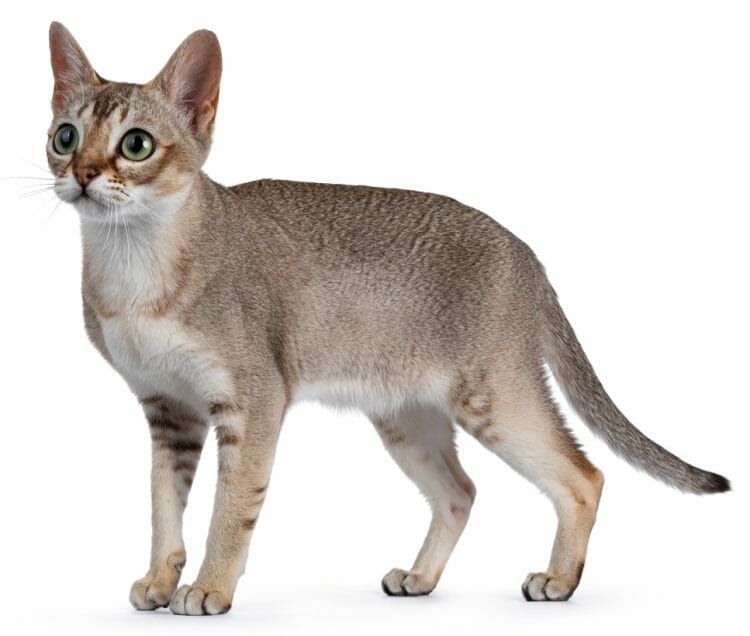
Singapura Cat Lifespan
Generally, the Singapura is a healthy breed with a relatively long life expectancy between 11 and 15 years, with some living for as many as 18 years. It is important to provide regular visits to the vet and appropriate vaccinations, such as those for feline panleukopenia, rabies, and feline leukemia.
Singapura Cat Adoption
When looking for a Singapura cat for sale, it is important to always check with rescue centers first. Many pets are given up or abandoned by their owners and will end up in shelters. When selecting a rescue center, look for a no-kill shelter as they will never euthanize a healthy animal.




